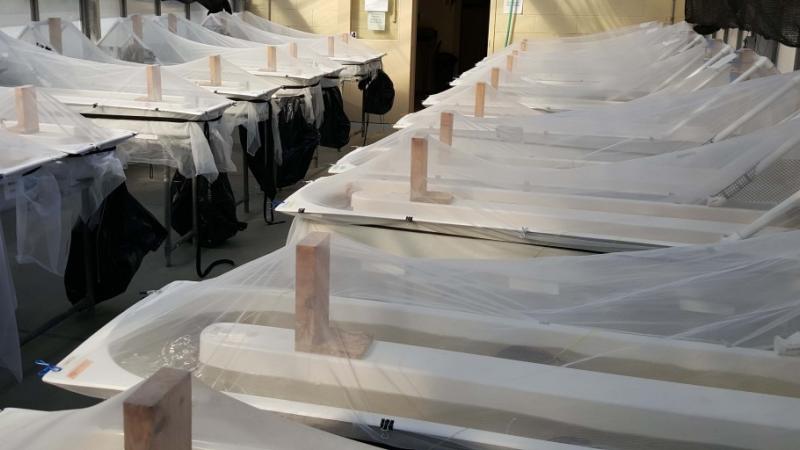December 14, 2016

(In this guest post, Aaron Stoler, a postdoctoral researcher in the lab of Rensselaer biologist and Jefferson Project at Lake George Director Rick Relyea, discusses how the Relyea lab investigates the impact of stressors on stream communities. This research is part of the Jefferson Project – a collaboration between Rensselaer, IBM Research, and The FUND for Lake George – founded to develop a new model for technologically enabled environmental monitoring and prediction to better understand and protect the Lake George ecosystem and freshwater ecosystems around the world.)
As use of de-icing salts on roads throughout North America increases, salt concentrations on land and in the water have dramatically increased. Snow melt carries salt away from the roads where it was deposited, and into streams that ultimately feed into lakes. As part of their research into the effects of road salt pollution on lake ecosystems, researchers from the Jefferson Project at Lake George have started chasing the problem upstream to the headwaters where aquatic contamination first occurs. In these small streams, salt levels can reach levels that are two orders of magnitude higher than in lakes. This is not life as normal for communities of organisms that are used to pure freshwater.
To understand the effects of road salt contamination in headwater streams, researchers are using artificial streams housed at the Cary Institute of Ecosystem Studies in Milbrook, New York. There, fellow Rensselaer postdoctoral researcher Bill Hintz and myself have partnered with senior scientist Emma Rosi-Marshall to explore how pristine stream communities change when exposed to increased concentrations of road salt.
If road salt contamination damages stream ecosystems, it could be very problematic for downstream lake ecosystems. Streams are not just the source of water for most lakes; they are also the source of many nutrients and food for fish and other species that live in the lakes. Streams collect organic material from the surrounding landscape, such as leaf litter, sticks, and the soil that erodes after a rainfall. Bacteria, fungi, and algae consume and degrade this material. In turn, bacteria, fungi, and algae serve as food for aquatic insects, which serve as food for small fish. This means that every fish that you catch in a lake is made up mostly of nutrients that were once on land.
 The artificial streams we use to explore the impacts of stressors like salt on streams are simple but innovative: an oval-shaped trough (called a “raceway”) holds up to 60 liters of water, while a paddlewheel moves the water through the trough at a continuous speed. Only a few facilities in the world have such artificial streams, and the Jefferson Project is excited to make use of this rare resource.
The artificial streams we use to explore the impacts of stressors like salt on streams are simple but innovative: an oval-shaped trough (called a “raceway”) holds up to 60 liters of water, while a paddlewheel moves the water through the trough at a continuous speed. Only a few facilities in the world have such artificial streams, and the Jefferson Project is excited to make use of this rare resource.
To start the experiment, we seeded each trough with leaf litter, rocks, and insects collected from a natural stream at the beginning of autumn. We then contaminated the artificial streams with road salt. One month after contaminating streams, we measured activity levels of bacteria, fungi, and algae, and have also measured how multiple species of stream insects responded to the salt.
We have just completed our first experiment to assess the effects of road salt on stream ecosystems. Although we are still processing the samples, we’ve already seen some pretty stunning results. Within days after salt contamination, streams with high levels of salt were stained brown. We think this is a result of faster leaf litter decomposition in salt-contaminated streams. Faster litter decomposition means that more nutrients are available to microbes and insects. However, we found very few living insects in the high-salt streams, which suggests that high-salt levels are lethal to many freshwater insects.
Our team plans to replicate the study during the spring of 2017. In addition, we hope to continue the collaboration with the Cary Institute to further investigate how road salt contamination might interact with other stressful sources of pollution, such as pesticides, fertilizers, and pharmaceutical compounds. Combinations of contaminants are often found in natural systems and can have more harmful consequences on aquatic communities than contamination by individual contaminants. For example, our recently published research in the journal Environmental Toxicology and Chemistry showed some interactive and negative effects of combining a common insecticide with road salt in wetlands.
By examining the detailed effects of road salt in a variety of aquatic ecosystems, the Jefferson Project is uncovering how human activities affect both lakes and the larger surrounding landscape. In the future, this research will help to improve the management of human development in and around our natural ecosystems.
